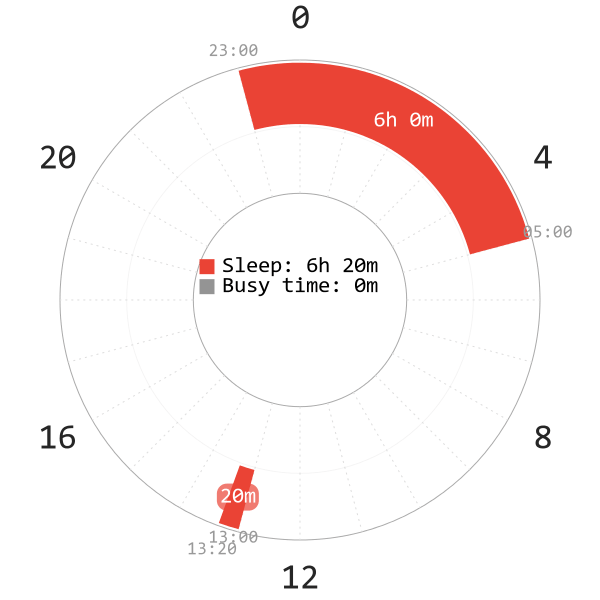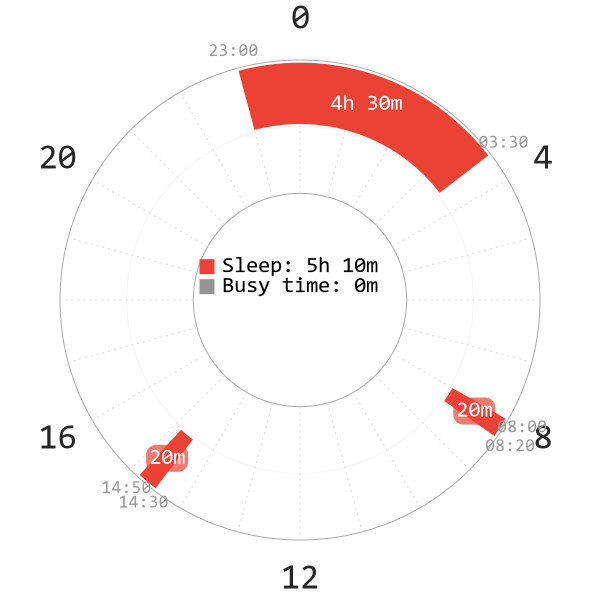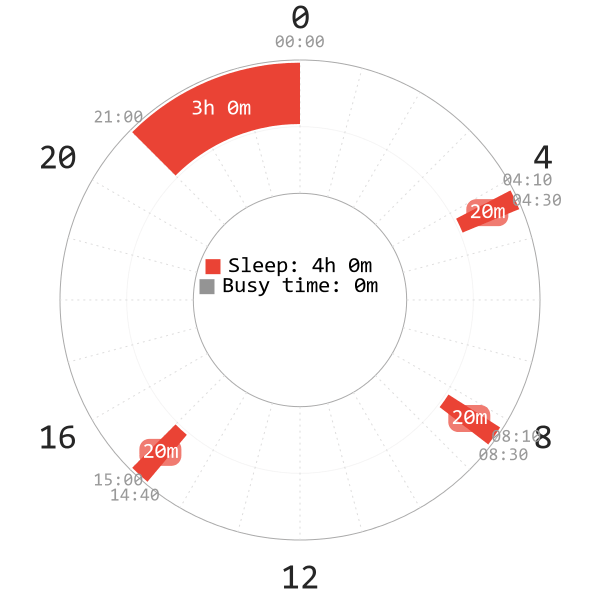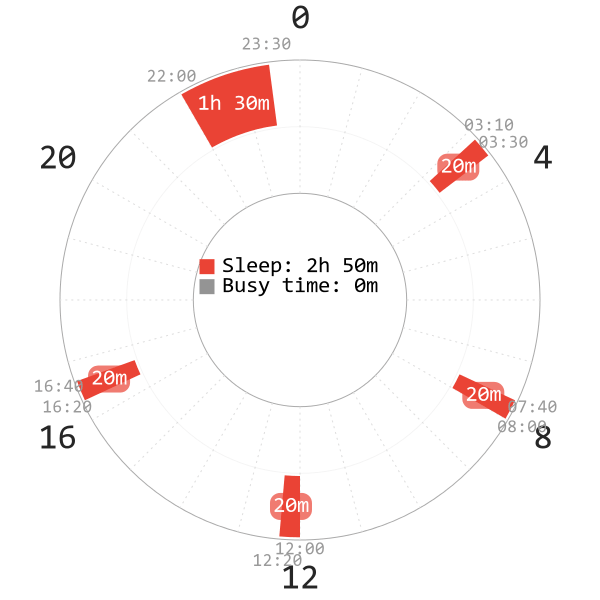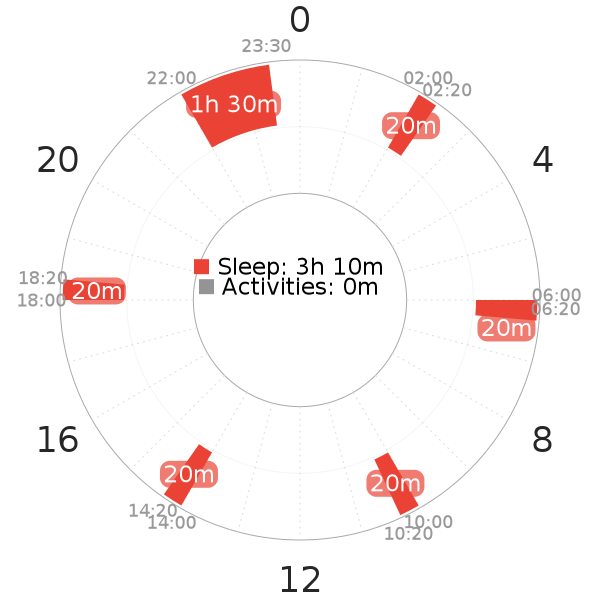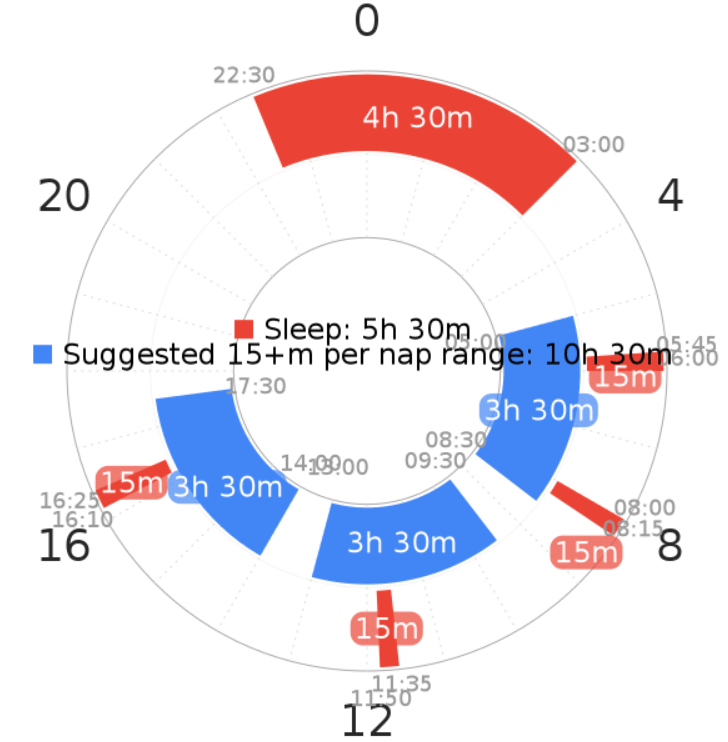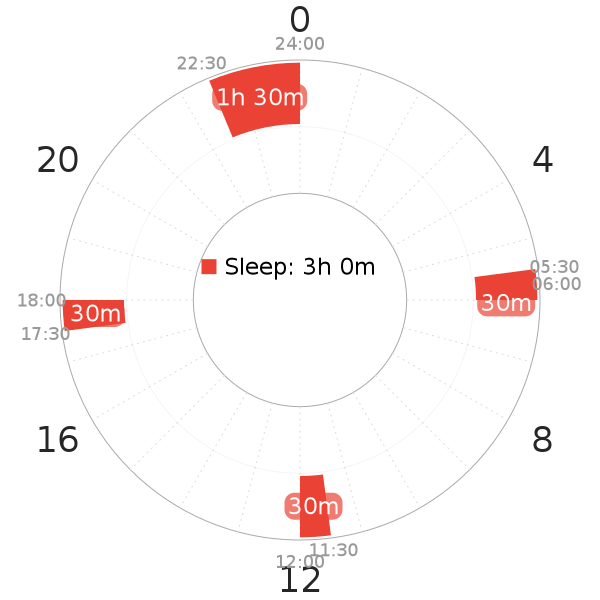EVERYMAN
Everyman sleep is a less extreme alternative to Uberman. Puredoxyk, who named and popularized Uberman, eventually proposed Everyman. It then became E3 to adapt to less sleep more easily while promoting nap flexibility. She reported this as sustainable once her child was a few years old; someone else would watch the child during her naps.
By 2008, Everyman sleep became known for being the “fallback” schedule for failed Uberman attempts. The first wave of Uberman attempts after Puredoxyk in the early 2000s spurred a wave of Everyman 3 attempts. In addition, personal growth blogger Steve Pavlina’s grueling adaptation log stirred another wave of Uberman attempts.
Nevertheless, Uberman attempters reported uncontrollable crashes for several hours every couple days or so.
- Thus, it made sense to then convert those crashes into its own schedule with a 3-hour core.
- In addition, this core soon developed a variant with a 3.5 hour core. At the time, this variant was “Everyman 3.5” to suggest its core duration. This may be confusing at times as this site uses the naming convention based on the number of naps instead.
- The extra 30 minutes enables higher nap flexibility and a slightly easier adaptation. This is largely owing to the larger amount of REM in the core.
Invention of Other Everyman Variants
- After the advent of E3, Everyman 2 came into existence as an even easier variant with a longer core and 2 naps.
- Moreover, Puredoxyk developed Everyman 4 as a superhuman compromise between the sustainable E3 and the extreme Uberman. Thus, together with E5, it is only sustainable by few individuals with genetic or acquired extreme sleep resilience or efficiency.
- Everyman 1 has a 6 hour core and 1 nap. However, some people may appear to follow this sleep pattern in modern society. However, most people rarely hold strict sleep times; it is more common to see about 7 hours plus a nap. Strict times allow for greater sleep reduction.
In the recent years, more Everyman variations also showed up for different purposes. These 2 variations are Trimaxion (to transition to Dymaxion) and the highly flexible SEVAMAYL.
Everyman 1 (6 hrs 20 minutes)
- Proposed by: Puredoxyk
- Total sleep: 6 hours 20 minutes
- Classification: Biphasic schedule
- Specification: 1 long core sleep, 1 REM nap
- Mechanics: 1 core sleep (4 full cycles), 1 nap
- Adaptation difficulty: Moderate
- Ideal scheduling: Core close to midnight, early-afternoon nap
- Former schedule names include: Everyman 6, Biphasic (schedule), short Siesta
It is most useful to consider E1 as a member of the Biphasic category of schedules. This is because it only has 2 sleep blocks.
Occasionally, E1 adaptation is a low-risk entryway for future adaptation to E2, E3, or E3-extended. See Adaptation.
Everyman 2 (5 hrs and 10 minutes)
- Proposed by: Puredoxyk
- Total sleep: 5 hours 10 minutes
- Classification: Everyman schedule
- Specification: 1 long core sleep, 2 REM naps
- Mechanism: 1 core sleep (3 full cycles), 2 naps
- Adaptation difficulty: Moderate
- Ideal scheduling: Core close to midnight, nap before work, early-afternoon nap. However, the second nap may contain only light sleep in some cases.
- Former schedule names include: E4.5, E5 (variant)
Everyman 3 (4 hours)
- Proposed by: Puredoxyk
- Total sleep: 4 hours (or 4 hours 30 minutes, with 3 hours 30 minutes core variant)
- Classification: Everyman schedule
- Specification: 1 core, 3 naps
- Mechanism: 1 main sleep (2 full cycles), 3 REM naps
- Adaptation difficulty: Hard
- Ideal scheduling: Core starts as close to dusk as possible (around 21:00) to gain more SWS. One nap is around 04:00, one nap post-dawn and one early-afternoon nap. All naps should contain REM and little light sleep only. However, the last nap may contain predominantly light sleep on extended version, or in people with low REM requirement.
- Former schedule names include: Everyman, E3.5 (variant)
Everyman 4 (2 hrs and 50 minutes)
- Proposed by: Puredoxyk
- Total sleep: 2 hours 50 minutes
- Classification: Everyman schedule
- Specification: 1 min-length core (1 full cycle), 4 REM naps
- Mechanism: 1 core sleep before midnight to gain as much SWS as possible, 4 naps should theoretically only contain REM. However, the last nap may contain purely or mostly SWS.
- Adaptation difficulty: Extreme
- Ideal scheduling: Core before midnight, 2 naps before the day starts, noon nap, afternoon nap.
- Former schedule name include: E1.5
Everyman 5 (3 hrs and 10 minutes)
- Proposed by: Puredoxyk
- Total sleep: 3 hours 10 minutes
- Classification: Everyman schedule
- Specification: 1 min-length core (1 full cycle), 5 REM naps
- Mechanism: 1 core sleep before midnight to gain as much SWS as possible. 5 naps should theoretically only contain REM. However, the last nap may contain purely or mostly SWS.
- Adaptation difficulty: Extreme
- Ideal scheduling: Core before midnight, naps placed in an Uberman timing fashion.
Sleep Everyman As Much As You Like (SEVAMAYL)
- Proposed by: Aethermind
- Total sleep: Undefined, but may average around 5-6 hours
- Classification: Flexible schedule, SPAMAYL variant, Everyman variant
- Specification: 1 core, multiple short naps
- Mechanism: Variant of SPAMAYL that includes a core sleep. Evolves well from adaptation to E3-extended, then E3-extended-flex as a helpful intermediate. The core sleep provides SWS and some REM, with several naps providing the remaining REM. A strong reliance on sensing when to best nap to get quality REM naps is necessary. You will need the freedom to take a nap soon at any time, and/or the ability to plan naps sensibly for each day to avoid excessive tiredness from long wake gaps.
- Adaptation difficulty: Hard
- Ideal scheduling: Around a 4-5 hour core, with about 2-6 naps of 10-20 minutes in length. Favor natural wakes. Cycles may naturally compress to 80m with frequent sleeps. Plan for 90m cycles until there are many early natural wakes. Nap spacing should take into account natural periods of tiredness, as well as the morning circadian peak. In the evening, 6-7 hour gaps are common; however, alertness may wane after 3-4 hours awake in the morning. A longer Pronap of up to 45m might be plausible during REM peak (6-9am) if the core already covers all SWS requirements; this should be the case if the base strict schedule has already been adapted to. This would allow larger gaps and/or increased flexibility later in the day. The core might be flexed and/or varied max. 90m in length, as optional variables after adapting to a base schedule. It is not advisable to add an extra cycle more than once a week; more frequent lengthening seems to destabilize adaptations to the reduced sleep total.
Trimaxion
- Invented by: GeneralNguyen
- Total sleep: 3 hours
- Classification: Dymaxion transitional schedule in an Everyman style
- Specification: 1 core sleep of 1 full cycle, 3 Dymaxion naps
- Mechanism: 4 sleeps per day. The core sleep is before midnight for most SWS; naps contain REM/mixed sleep stages. Circadian spots include: Core sleep around dusk, dawn nap, noon nap, and evening nap. There are mixed sleep stages in all 3 naps, possibly pure-REM or even pure-SWS nap. Trimaxion is more flexible than Dymaxion because of the core sleep; thus, after adaptation 3 naps can be slightly flexible.
- Adaptation difficulty: Extreme
- Ideal scheduling: Distribution of sleep resembles Dymaxion. Otherwise, it is a transition step to Dymaxion and also as a fallback from Dymaxion should adaptation fail.
Comparison between Everyman Schedules
NOTE:
- The assessment table showcases differences between Everyman schedules, based on standard scheduling.
- Unless specified otherwise, there are no mentions on extended versions.
- The table does not account for short sleepers; thus, these criteria will likely vary in them.
- Assessment denotations:
- 4/4: Positive, very high viability, or very easy
- 3/4: Somewhat decent viability, above average, or somewhat easy
- 2/4: Neutral, medium viability
- 1/4: Overall negative, low viability, below average, or difficult
| Criteria | E2 | E3 | E4 | E5 | SEVAMAYL | Trimaxion |
| Exercising | ||||||
| Time zone travel (> 5h) | ||||||
| Evening social time (18:00-23:00) |
| |||||
| Daytime napping (07:30-17:00) | ||||||
| Schedule nap around meal time | ||||||
| Overall flexibility |
| |||||
| Flexible core |
| |||||
| Hidden potential(s) | 5h core, Pronap | Extended, 3.5h core | Extended | None | Varying nap duration | None |
| Criteria | ……E2…… | E3 |
| Exercising | ||
| Time zone travel (> 5h) | ||
| Evening social time (18:00-23:00) |
| |
| Daytime napping (07:30-17:00) | ||
| Schedule nap around meal time | ||
| Overall flexibility |
| |
| Flexible core |
| |
| Hidden potential(s) | 5h core, Pronap | Extended, 3.5h core |
| Criteria | E4 | …..E5….. |
| Exercising | ||
| Time zone travel (> 5h) | ||
| Evening social time (18:00-23:00) | ||
| Daytime napping (07:30-17:00) | ||
| Schedule nap around meal time | ||
| Overall flexibility | ||
| Flexible core | ||
| Hidden potential(s) | Extended | None |
| Criteria | SEVAMAYL | Trimaxion |
| Exercising | ||
| Time zone travel (> 5h) | ||
| Evening social time (18:00-23:00) | ||
| Daytime napping (07:30-17:00) | ||
| Schedule nap around meal time | ||
| Overall flexibility | ||
| Flexible core | ||
| Hidden potential(s) | Varying nap duration | None |
Brief Analysis
- All the Everyman schedules share the same benefit of scheduling nap around meal time. Since the nap is short, it is easy to schedule before or some hours after a meal. However, the excessive number of naps on E5 can make meal scheduling more difficult.
- Travelling to different time zones makes it overall difficult to sustain Everyman schedules, especially those with a short core.
- Everyman variants with at least a 4.5h core (e.g, E2, SEVAMAYL) can place the core around 23:00-midnight. Therefore, they have a great advantage for evening social time.
- Likewise, Everyman variants with fewer than 2 daytime naps per day have strong viability to maintain the napping habit long term. This includes E2 and SEVAMAYL, the latter of which has very flexible nap timing to afford ~2-3 daytime naps. This criteria is based on the ability to schedule naps in mainstream occupations (e.g, 9-to-5) and if at least one nap is permissible at work.
- The Everyman line also has flexibility in sleep timing after adaptation. However, for the most part, only the naps can be very flexible. The core needs to be long enough (at least ~3.5h) for some flexibility. A lot of adapted sleepers have had difficulty flexing the core.
- The hidden potentials of each Everyman schedule indicate strong alternatives for a successful adaptation. This is important because beginners often overlook these niches.
- SEVAMAYL is not the only flexible Everyman schedule. Any other Everyman schedules may be flexible to some degree after adaptation. SEVAMAYL is a whole new adaptation altogether, with more advanced sleep flexing mechanics.
- Most importantly, a core duration should be at least 4.5h long to facilitate more regular exercises and recovery.
Comparison between Everyman & Dual Core Schedules
NOTE: The assessment criteria and denotations are the same as the table from the previous section.
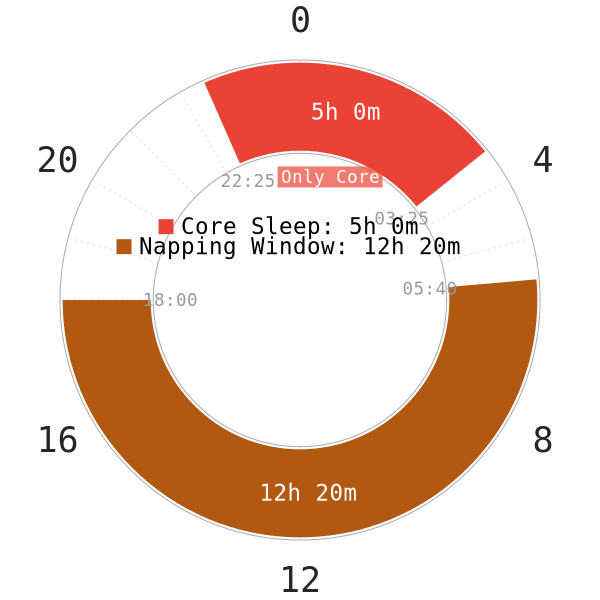
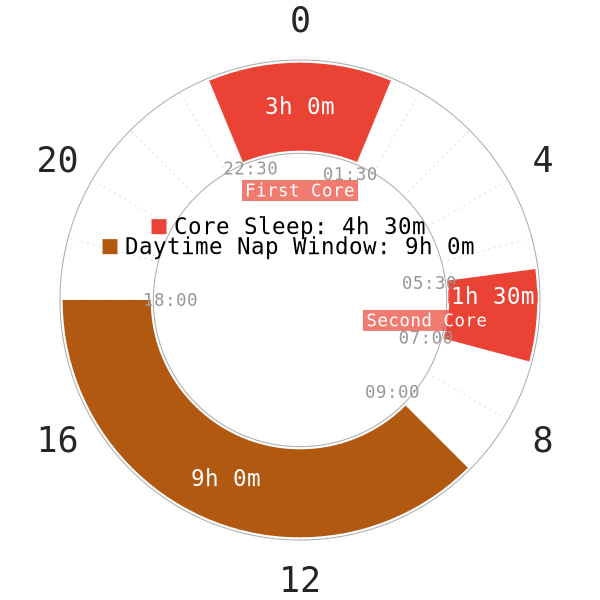
| List of characteristics | Dual Core | Everyman |
| Transitioned from | Segmented Sleep | Everyman 1 |
| Number of core sleep(s) | 2 | 1 |
| Number of naps | 1+ | 2+ |
| Pronap application | No | Yes (E2 or E3) |
| Dusk sleep (21:00-24:00) | 1 core sleep | Optional (E2) Recommended (E3, E4) |
| Dawn sleep (06:00-09:00) | 1 core sleep, 1 nap in the case of DC3 | 1 nap or 1 Pronap |
| Most commonly used core durations | Dusk core: 4.5h, 3h, 3.3h, Dawn core: 3h, 1.7h, 1.5h | 6h, 5h, 4.5h, 3.5h, 3h |
| Most flexible variation | DUCAMAYL | SEVAMAYL |
| Night shift viability | ||
| Dark period scheduling convenience | ||
| Suitable for | Naturally segmented sleepers | Non-interrupted monophasic sleep at night |
| Adaptation difficulty | Overall somewhat more difficult than Everyman for non-Segmented sleepers | Overall easier start than Dual Core |
| Time zone traveling (> 3h difference) | ||
| Best suited for exercising | DC1-extended, DC2-extended, or DC2 | E2, E2-extended, E3-extended |
| Evening social time (18:00-23:00) | Only extended variants where dusk core can start at 23:00 | Late core can work (mostly E2, E2-extended, E3-extended) |
| Daytime social/work time (7:30-17:00) | High viability with 1 nap during these hours, medium/weak viability for 1+ naps | Same as Dual Core |
| Flexibility | Somewhat strong viability in only extended variants | Strong viability even in non-extended variants (except E4 and some E3) |
| Flexible core | High potential (> 1h change in sleep time) in extended variants (> 5.5h TST) | High potential in non-extended variants, very high in extended variants |
| Hidden potential(s) | Dawn core can make up for dusk core’s disruptions in sleep quality | More naps can be scheduled if core is disrupted in sleep quality |
| List of characteristics | Dual Core | Everyman |
| Transitioned from | Segmented Sleep | Everyman 1 |
| Number of core sleep(s) | 2 | 1 |
| Number of naps | 1+ | 2+ |
| Pronap application | No | Yes (E2 or E3) |
| Dusk sleep (21:00-24:00) | 1 core sleep | Optional (E2) Recommended (E3, E4) |
| Dawn sleep (06:00-09:00) | 1 core sleep, 1 nap in the case of DC3 | 1 nap or 1 Pronap |
| Most commonly used core durations | Dusk core: 4.5h, 3h, 3.3h, Dawn core: 3h, 1.7h, 1.5h | 6h, 5h, 4.5h, 3.5h, 3h |
| Most flexible variation | DUCAMAYL | SEVAMAYL |
| Night shift viability | ||
| Dark period scheduling convenience | ||
| Suitable for | Naturally segmented sleepers | Non-interrupted monophasic sleep at night |
| Adaptation difficulty | Overall somewhat more difficult than Everyman for non-Segmented sleepers | Overall easier start than Dual Core |
| Time zone traveling (> 3h difference) | ||
| Best suited for exercising | DC1-extended, DC2-extended, or DC2 | E2, E2-extended, E3-extended |
| Evening social time (18:00-23:00) | Only extended variants where dusk core can start at 23:00 | Late core can work (mostly E2, E2-extended, E3-extended) |
| Daytime social/work time (7:30-17:00) | High viability with 1 nap during these hours, medium/weak viability for 1+ naps | Same as Dual Core |
| Flexibility | Somewhat strong viability in only extended variants | Strong viability even in non-extended variants (except E4 and some E3) |
| Flexible core | High potential (> 1h change in sleep time) in extended variants (> 5.5h TST) | High potential in non-extended variants, very high in extended variants |
| Hidden potential(s) | Dawn core can make up for dusk core’s disruptions in sleep quality | More naps can be scheduled if core is disrupted in sleep quality |
Brief analysis
- The immediate indicator to choose a Dual Core or Everyman schedule to adapt to is to see if one continually has an interrupted monophasic pattern at night.
- Dual Core has a disadvantage compared to Everyman when it comes to evening social time. This is because of the first core of Dual Core, which often resides in SWS peak. Although DUCAMAYL and extended versions improve that weakness, the first core remains a vulnerable target. Still, with the addition of the dark period, it just seems overall more convenient to schedule Everyman.
- The split core mechanics and potentially the core durations also do not usually follow the 90m cycle. As a result, this makes Dual Core usually harder to adapt to than Everyman, based on adaptation history.
- Dual Core sleep overall has a higher total sleep than Everyman.
- Naps on both schedule lines are usually flexible after adaptation.
- The ability to use the sleep peaks allows Dual Core schedules to meet personal REM baseline compared to Everyman variants. In fact, the second core of Dual Core is often replete with REM sleep.
- So far Everyman sleep has some edge over Dual Core sleep during shift work situations. It has an anecdotally higher adaptation success rate.
- Surprisingly, there has been overall more research documents on Dual Core type of sleep than on Everyman sleep. For example, Segmented sleep, the origin of Dual Core sleep, is one of the most natural sleep patterns. Thus, more research on Everyman sleep is necessary to see how natural a system of multiple short naps can be.
Overall, both schedule lines have their own fortes. Therefore, a complete adaptation on any schedules should be a priority over the amount of sleep reduction.
Main author: Crimson & GeneralNguyen
Page last updated: 11 January 2021









